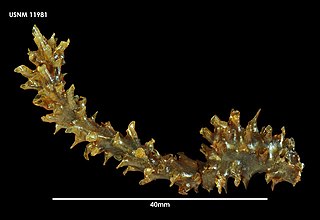Related Research Articles

Pterobranchia is a class of small worm-shaped animals. They belong to the Hemichordata, and live in secreted tubes on the ocean floor. Pterobranchia feed by filtering plankton out of the water with the help of cilia attached to tentacles. There are about 25 known living pterobranch species in three genera, which are Rhabdopleura, Cephalodiscus, and Atubaria. On the other hand, there are several hundred extinct genera, some of which date from the Cambrian Period.
The pterobranchia mitochondrial code is a genetic code used by the mitochondrial genome of Rhabdopleura compacta (Pterobranchia). The Pterobranchia are one of the two groups in the Hemichordata which together with the Echinodermata and Chordata form the three major lineages of deuterostomes. AUA translates to isoleucine in Rhabdopleura as it does in the Echinodermata and Enteropneusta while AUA encodes methionine in the Chordata. The assignment of AGG to lysine is not found elsewhere in deuterostome mitochondria but it occurs in some taxa of Arthropoda. This code shares with many other mitochondrial codes the reassignment of the UGA STOP to tryptophan, and AGG and AGA to an amino acid other than arginine. The initiation codons in Rhabdopleura compacta are ATG and GTG.
The yeast mitochondrial code is a genetic code used by the mitochondrial genome of yeasts, notably Saccharomyces cerevisiae, Candida glabrata, Hansenula saturnus, and Kluyveromyces thermotolerans.
The mold, protozoan, and coelenterate mitochondrial code and the mycoplasma/spiroplasma code is the genetic code used by various organisms, in some cases with slight variations, notably the use of UGA as a tryptophan codon rather than a stop codon.
The invertebrate mitochondrial code is a genetic code used by the mitochondrial genome of invertebrates. Mitochondria contain their own DNA and reproduce independently from their host cell. Variation in translation of the mitochondrial genetic code occurs when DNA codons result in non-standard amino acids has been identified in invertebrates, most notably arthropods. This variation has been helpful as a tool to improve upon the phylogenetic tree of invertebrates, like flatworms.
The echinoderm and flatworm mitochondrial code is a genetic code used by the mitochondria of certain echinoderm and flatworm species.
The alternative yeast nuclear code is a genetic code found in certain yeasts. However, other yeast, including Saccharomyces cerevisiae, Candida azyma, Candida diversa, Candida magnoliae, Candida rugopelliculosa, Yarrowia lipolytica, and Zygoascus hellenicus, definitely use the standard (nuclear) code.
The candidate division SR1 and gracilibacteria code is used in two groups of uncultivated bacteria found in marine and fresh-water environments and in the intestines and oral cavities of mammals among others. The difference to the standard and the bacterial code is that UGA represents an additional glycine codon and does not code for termination.
The ascidian mitochondrial code is a genetic code found in the mitochondria of Ascidia.
The alternative flatworm mitochondrial code is a genetic code found in the mitochondria of Platyhelminthes and Nematodes.
The chlorophycean mitochondrial code is a genetic code found in the mitochondria of Chlorophyceae.
The trematode mitochondrial code is a genetic code found in the mitochondria of Trematoda.
The Scenedesmus obliquusmitochondrial code is a genetic code found in the mitochondria of Scenedesmus obliquus, a species of green algae.
The Thraustochytrium mitochondrial code is a genetic code found in the mitochondria of the labyrinthulid protist Thraustochytrium aureum. The mitochondrial genome was sequenced by the Organelle Genome Megasequencing Program.
The pachysolen tannophilus nuclear code is a genetic code found in the ascomycete fungus Pachysolen tannophilus.
The karyorelictid nuclear code is a genetic code used by the nuclear genome of the Karyorelictea ciliate Parduczia sp.
The Condylostoma nuclear code is a genetic code used by the nuclear genome of the heterotrich ciliate Condylostoma magnum.
The Mesodinium nuclear code is a genetic code used by the nuclear genome of the ciliates Mesodinium and Myrionecta.
The peritrich nuclear code is a genetic code used by the nuclear genome of the peritrich ciliates Vorticella and Opisthonecta.
The Blastocrithidia nuclear code is a genetic code used by the nuclear genome of the trypanosomatid genus Blastocrithidia.
References
This article incorporates text from the United States National Library of Medicine, which is in the public domain. [3]
- ↑ Li, Yuanning; Kocot, Kevin M.; Tassia, Michael G.; Cannon, Johanna T.; Bernt, Matthias; Halanych, Kenneth M. (2019-01-01). "Mitogenomics Reveals a Novel Genetic Code in Hemichordata". Genome Biology and Evolution. 11 (1): 29–40. doi:10.1093/gbe/evy254. PMC 6319601 . PMID 30476024.
- ↑ Perseke M, Hetmank J, Bernt M, Stadler PF, Schlegel M, Bernhard D (May 2011). "The enigmatic mitochondrial genome of Rhabdopleura compacta (Pterobranchia) reveals insights into selection of an efficient tRNA system and supports monophyly of Ambulacraria". BMC Evol Biol. 11 (134): 134. doi: 10.1186/1471-2148-11-134 . PMC 3121625 . PMID 21599892.
- ↑ Elzanowski A, Ostell J, Leipe D, Soussov V. "The Genetic Codes". Taxonomy browser. National Center for Biotechnology Information (NCBI), U.S. National Library of Medicine. Retrieved 7 January 2019.